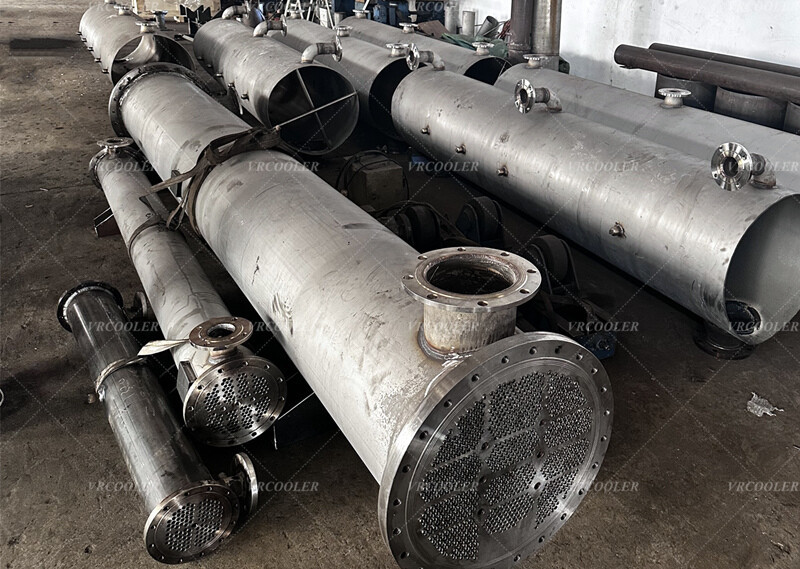Shell and Tube Biogas Heat Exchanger
Structural characteristics
Shell: usually cylindrical, made of rolled and welded steel plate, it is the external container that holds the heat exchange medium and biogas, and can withstand certain pressure and temperature.
Tube bundle: It consists of several heat exchanger tubes, usually made of stainless steel or carbon steel to ensure corrosion resistance and good thermal conductivity. The tubes are arranged in triangles, squares, etc. Different arrangements affect the fluid flow characteristics and heat transfer efficiency.
Tube plate: Located at both ends of the tube bundle, it is used to fix the heat exchanger tubes and separate the fluids in the tube and shell processes. The connection between tube plate and heat exchanger tube can be expanded, welded or combined with expansion and welding.
Head: installed at both ends of the shell, connected with the tube plate, the role of which is to make the fluid in the tube or shell process uniform distribution, the common form of head oval, spherical, etc..
Folding plate: installed in the shell process, used to guide the shell process fluid flow, increase the fluid flow rate and degree of turbulence, improve the efficiency of heat transfer, but also play a role in supporting the tube bundle, to prevent the heat transfer tube vibration due to fluid impact.
Working Principle
The working principle of the shell and tube biogas heat exchanger is based on heat conduction and convection heat transfer. Biogas and another heat transfer medium (e.g. hot water, steam or air) flow in a tube and shell course respectively. When there is a temperature difference between the two fluids, heat is transferred from the high temperature fluid to the low temperature fluid through the tube wall. The specific process is as follows:
The high temperature fluid (e.g., biogas) flows in the tube or shell course and transfers heat to the tube wall, a process that is mainly realized by convective heat transfer.
The heat is conducted through the wall of the tube, and due to the good thermal conductivity of the wall, the heat can be transferred quickly from one side to the other.
The low-temperature fluid flows on the other side and absorbs heat from the pipe wall through convection heat transfer, thus realizing the heat exchange between the two fluids.
Design Points
Diameter and length of heat exchanger tube: Determined according to the biogas flow rate, temperature, pressure and heat exchange requirements. Generally speaking, a larger diameter heat exchanger tube can be selected when the flow rate is larger in order to reduce the fluid resistance; while the length or number of heat exchanger tubes can be increased for the case of higher heat exchange area requirement.
Selection of pipe length and shell length: Consider the nature, flow rate, pressure and other factors of biogas and heat transfer medium. Usually, more corrosive, higher pressure or smaller flow rate of the fluid is suitable for tube range, easy to seal and prevent leakage; while the flow rate is larger, easy to scale the fluid is suitable for shell range, which is conducive to cleaning and maintenance.
Folding plate design: folding plate spacing, shape and number of shell process fluid flow state and heat transfer effect has an important impact. Reasonable design of folding plate can make the shell fluid form turbulence and improve the heat exchange coefficient, but at the same time, we should avoid excessive fluid resistance.
Material selection: Select the suitable material according to the characteristics of biogas and heat transfer medium. For the biogas side, because the biogas may contain hydrogen sulfide and other corrosive components, generally use corrosion-resistant stainless steel or carbon steel and anticorrosion treatment; for the side of the heat transfer medium, according to the nature of the selection of corrosion-resistant, heat conduction of the material with good performance.
Maintenance
Regular cleaning: After running for a period of time, the surface of the heat exchanger tube may scale or accumulate impurities, affecting the heat transfer efficiency. Chemical cleaning or mechanical cleaning methods can be used to remove the dirt, such as the use of suitable cleaning agent cycle cleaning tube course and shell course, or high pressure water gun flushing shell course within the folding plate and the surface of the heat exchanger tube.
Check the sealing performance: check whether there is leakage in the sealing parts such as the connection between the tube plate and the heat exchanger tube, and the connection between the head and the shell. If there is leakage, promptly find the cause and repair, such as replacing the sealing gasket, re-welding or expansion.
Monitoring of corrosion: Regular corrosion testing of heat exchanger materials, especially the parts in contact with methane gas. If serious corrosion is found, timely measures should be taken, such as replacing damaged parts or strengthening anti-corrosion treatment.
Check the heat exchange effect: assess the heat exchange effect of the heat exchanger by monitoring the import and export temperature, pressure and other parameters of the biogas and heat exchange medium. If a decrease in heat exchange efficiency is found, analyze the reasons in time and make adjustments and maintenance accordingly.


